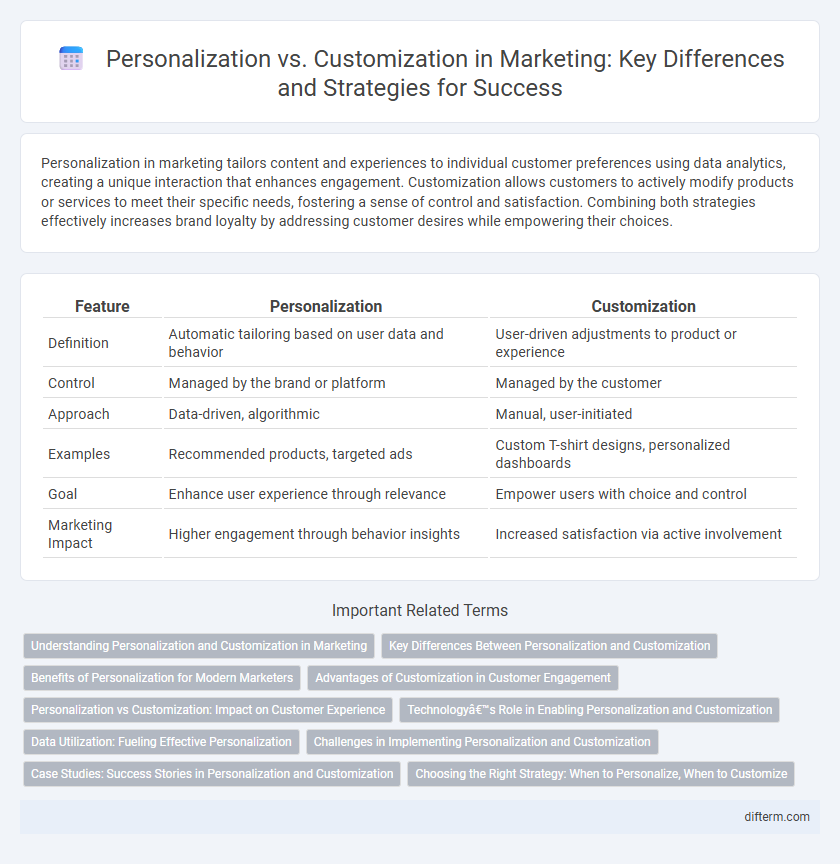Personalization in marketing tailors content and experiences to individual customer preferences using data analytics, creating a unique interaction that enhances engagement. Customization allows customers to actively modify products or services to meet their specific needs, fostering a sense of control and satisfaction. Combining both strategies effectively increases brand loyalty by addressing customer desires while empowering their choices.
Table of Comparison
| Feature | Personalization | Customization |
|---|---|---|
| Definition | Automatic tailoring based on user data and behavior | User-driven adjustments to product or experience |
| Control | Managed by the brand or platform | Managed by the customer |
| Approach | Data-driven, algorithmic | Manual, user-initiated |
| Examples | Recommended products, targeted ads | Custom T-shirt designs, personalized dashboards |
| Goal | Enhance user experience through relevance | Empower users with choice and control |
| Marketing Impact | Higher engagement through behavior insights | Increased satisfaction via active involvement |
Understanding Personalization and Customization in Marketing
Personalization in marketing involves tailoring content and experiences based on individual customer data such as browsing history, preferences, and behavior patterns, creating more relevant and engaging interactions. Customization allows customers to actively modify products or services to meet their specific needs, enhancing satisfaction and loyalty through user-driven choices. Understanding the distinction helps marketers effectively apply data-driven personalization to automate recommendations while offering customization options that empower consumer involvement.
Key Differences Between Personalization and Customization
Personalization leverages customer data and algorithms to automatically tailor marketing messages and product recommendations, enhancing user experience based on predicted preferences. Customization empowers consumers to manually adjust products or services to their specific needs and desires, providing direct control over features and options. The key difference lies in personalization being driven by data and automation, while customization relies on user-initiated choices to create unique brand interactions.
Benefits of Personalization for Modern Marketers
Personalization leverages data-driven insights to deliver tailored content and offers, significantly enhancing customer engagement and conversion rates for modern marketers. It enables real-time adaptation based on user behavior, resulting in higher retention and customer lifetime value. Incorporating AI-driven algorithms facilitates scalable personalization, optimizing marketing ROI and driving competitive advantage.
Advantages of Customization in Customer Engagement
Customization enhances customer engagement by allowing brands to offer tailored experiences that meet individual preferences and needs, resulting in higher satisfaction and loyalty. Customers feel valued when they can modify products or services to their specific requirements, fostering a stronger emotional connection with the brand. This approach drives increased conversion rates and repeat purchases by delivering a sense of ownership and uniqueness in the customer journey.
Personalization vs Customization: Impact on Customer Experience
Personalization uses data-driven insights to tailor content and offers automatically based on individual customer behavior, boosting engagement and satisfaction through relevant experiences. Customization allows customers to manually modify products or services to their preferences, enhancing control and perceived value. Both strategies improve customer experience, but personalization delivers proactive, seamless interactions, while customization emphasizes user-driven choice.
Technology’s Role in Enabling Personalization and Customization
Technology drives personalization and customization by leveraging data analytics, artificial intelligence, and machine learning to deliver tailored marketing experiences. Advanced algorithms analyze consumer behavior and preferences in real-time, enabling dynamic content adaptation and personalized product recommendations. Integration of CRM systems and automated marketing platforms enhances the scalability and precision of personalized and customized campaigns, boosting engagement and conversion rates.
Data Utilization: Fueling Effective Personalization
Data utilization is crucial for fueling effective personalization by enabling marketers to analyze customer behaviors, preferences, and purchase history to deliver tailored experiences. Personalization leverages real-time data and predictive analytics to adapt content and recommendations dynamically, whereas customization typically allows users to manually modify features based on their preferences. Harnessing big data and machine learning improves targeting precision, increases customer engagement, and drives higher conversion rates in personalized marketing campaigns.
Challenges in Implementing Personalization and Customization
Implementing personalization and customization in marketing faces challenges such as data privacy concerns, which limit the collection and use of customer information needed for precise targeting. Integrating diverse data sources and maintaining data accuracy complicate the development of personalized experiences, often requiring advanced analytics and AI technologies. Moreover, balancing personalization with scalability demands significant technological investment and organizational alignment to ensure consistent, relevant customer engagement across multiple channels.
Case Studies: Success Stories in Personalization and Customization
Case studies in marketing reveal that personalization enhances customer engagement by leveraging data-driven insights to tailor experiences at an individual level, significantly increasing conversion rates and brand loyalty. Customization empowers consumers to modify products or services according to their preferences, driving satisfaction and repeat purchases, as demonstrated by companies like Nike and Tesla. Combining personalization with customization strategies has resulted in measurable growth in customer retention and revenue across industries, underscoring their effectiveness in targeted marketing campaigns.
Choosing the Right Strategy: When to Personalize, When to Customize
Personalization tailors marketing efforts based on data-driven insights about individual customer behavior, preferences, and demographics, creating unique experiences at scale. Customization allows customers to actively modify products or services to meet their specific needs, enhancing engagement through direct involvement. Marketers should personalize when aiming to automate relevance across broad audiences and opt for customization when empowering customers to influence their purchase, optimizing satisfaction and loyalty.
Personalization vs customization Infographic

 difterm.com
difterm.com